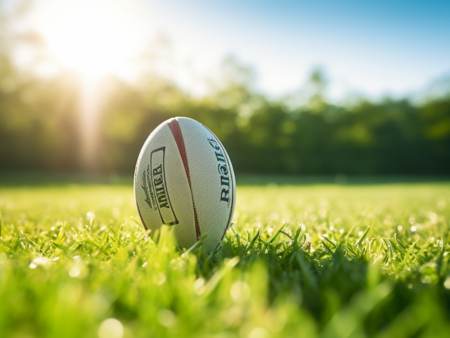Contents
Rules of Lacrosse
Lacrosse is an exciting and fast-paced sport that is enjoyed by players of all ages around the world, from professional athletes to amateur enthusiasts. Played with a small rubber ball and long-handled sticks, lacrosse combines elements of soccer, basketball, hockey, and rugby into a thrilling game of strategy and finesse which has been played by native North American populations since the 1600s.
Lacrosse Positions
The most important position in lacrosse is the attack, who are responsible for scoring goals and generating offense. Attackers need to be agile and creative and must possess the ability to make quick decisions when shooting or passing. Because this player is located closest to the opponent’s goal, they must also be able to maintain possession of the ball under pressure from defenders.
Midfielders are responsible for playing offense and defense at the same time, which requires them to have great stamina, agility, speed and passing skills. Midfielders should be well-rounded athletes who can transition quickly between the offensive and defensive sides of the ball. They are typically some of the hardest working players on the field since they have a lot of ground to cover.
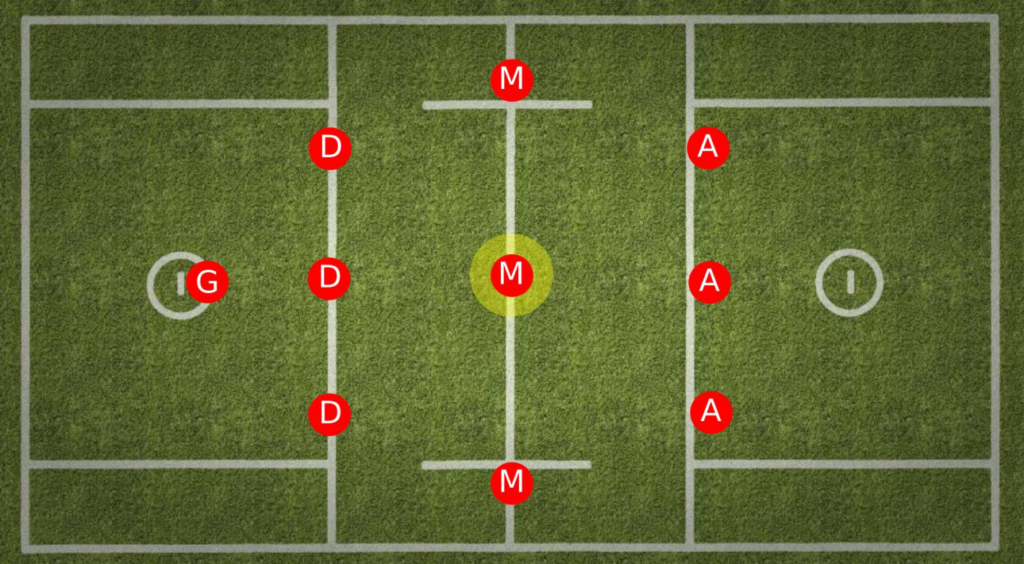
Defenders are tasked with stopping opponents from attacking their team’s goal by marking them tightly as they try to navigate around other players. Defenders must also be strong communicators in order to effectively organize their team’s defense strategy on the field. Since they are mainly focused on defending rather than creating offense, defenders generally tend to be larger than other positions so they can use their size as an advantage while fighting off attackers.
Goalies are arguably one of the most important defensive positions in lacrosse due to them being responsible for blocking shots taken by opponents at their own goal posts. This position requires extreme focus, reflexes and athleticism due to them having less time than any other player on the field to react and save incoming shots from entering their goal post area. Goalies usually wear protective equipment such as chest protection, headgear or throat guards since they often get bombarded by hard shot attempts from opposing forces during a match.
Number of Players
The number of players in a lacrosse game can vary depending on the type of game being played. Box lacrosse, which is more commonly known as indoor lacrosse, typically has five players per team on the field at one time. These players include three forwards, one defense, and one goalkeeper. Field lacrosse, or outdoor lacrosse, features ten players per team on the field at once; these players include three attackmen, three midfielders, three defensemen, and a goalie.
In addition to the set number of players that are allowed to be on the field during an official game, teams may also have additional reserve players who serve as substitutes for their respective teams when needed. These reserve players are responsible for taking the place of any player who needs to exit the game due to injury or fouls they have committed while playing. Lacrosse teams may also have coaches and other staff members present during a game in order to provide support and instruction throughout gameplay.
Lacrosse Field
A lacrosse field is a large outdoor playing area that is used for the sport of lacrosse. It typically includes two goals or nets at either end, and teams are usually divided into offense and defense. The size and shape of a lacrosse field varies depending on the league, age group, and level of play. Generally speaking, regulation fields measure 110 yards long by 60 yards wide and contain four 18-foot wide attack areas along each sideline. The goal posts are positioned six feet apart within the attack areas, while the center line is marked with a dashed line running through the middle of the field.
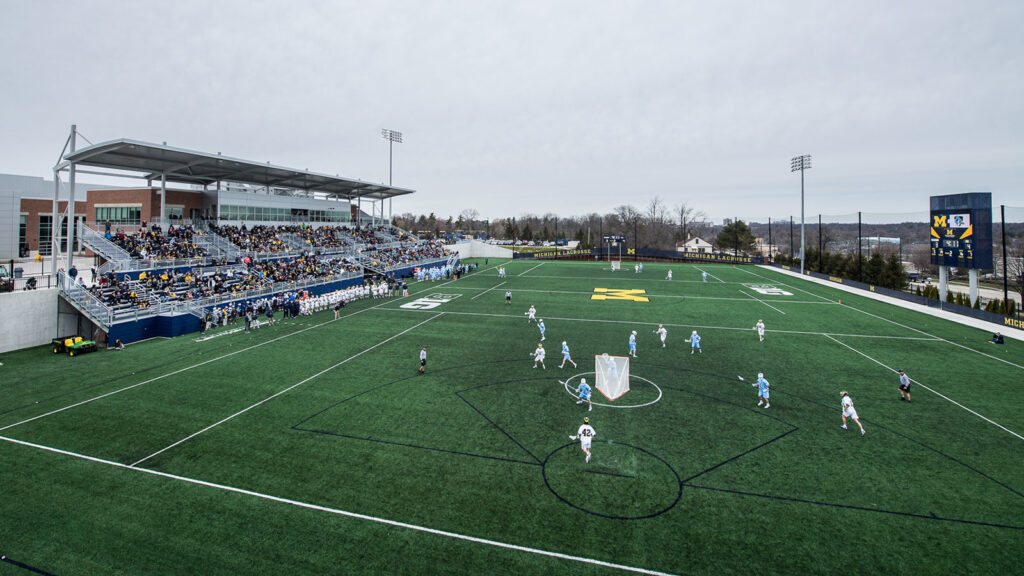
The boundaries of the lacrosse field have several significant markers, including sidelines, backlines, end lines, and goal lines. The sidelines mark out-of-bounds territory for players passing or shooting the ball across them; meanwhile, backlines designate how far players can move behind their respective goals before they must pass or shoot from in front of it. End lines designate where possession changes occur after a shot goes out of bounds (i.e., when possession switches to their opponent). Finally, goal lines indicate where shots must be taken from to score a goal – any closer than six feet from the post will result in a change in possession as well.
The grassy surface of a lacrosse field typically consists of two stripes down its length: one is yellow for indicating substitutions and possessions changes; while the other is white for marking offsides violations. In addition to these markings, there are also hash marks located five yards away from each sideline as well as 25-yard lines between midfield and either attack/defensive area (with an additional midline between these areas). Finally, many collegiate programs use bright orange dots placed 10 yards apart to help players better visualize how far they need to spread out during offensive plays.
Crease
The crease on a lacrosse field is an important element of the game. It is an 8-meter circle with a four foot radius located in each end zone, usually marked with white paint or lime chalk. It serves as the goal area and is where players can score a goal. The crease is not just important to the player trying to score, but also to all of the other players on the field. Within the crease area, no opposing players are allowed to enter unless they are defending against an opponent inside it. If opponents do enter the crease, it will result in a penalty for their team.
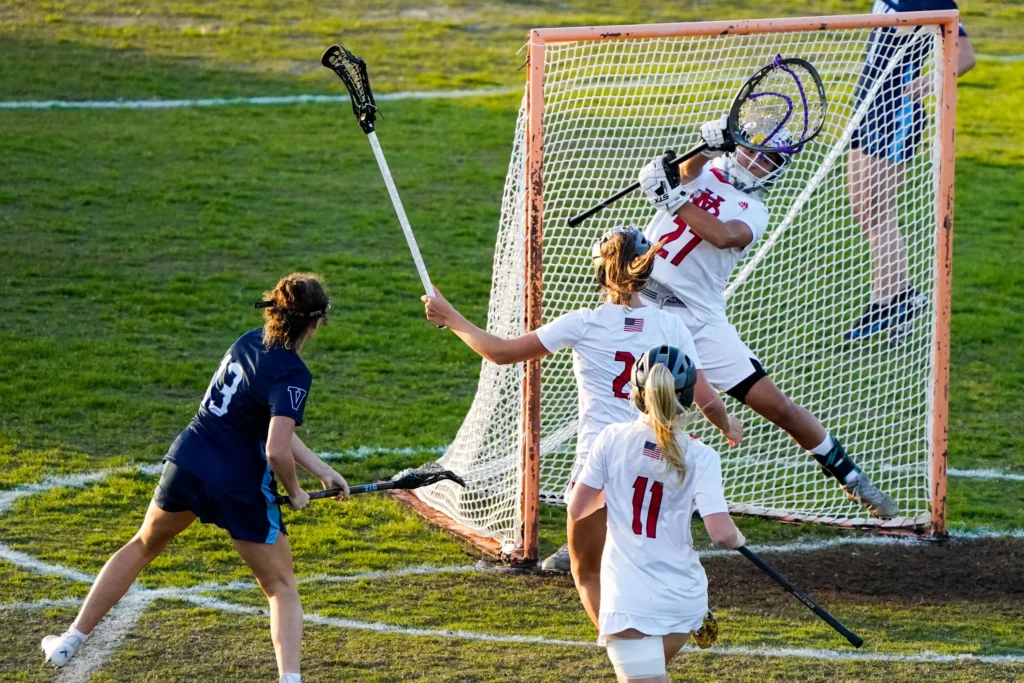
In addition to being used for scoring goals, the crease can also be used as a strategic tool during gameplay. Players can use it as a place to shield themselves from opposing players while they set up plays or pass off to teammates or shoot towards goal. It also can serve as a way for offensive players to protect themselves from checks and collisions with defenders when attacking goal.
Game Duration
The duration of a lacrosse game can depend on the level of play. In high school and college, lacrosse games typically last for two halves of 30 minutes each with a 15-minute halftime break. Games at the professional level, such as Major League Lacrosse (MLL) or National Lacrosse League (NLL), are 60 minutes long and divided into four quarters, with each quarter lasting 15 minutes and a halftime break in between.
From start to finish, including any overtime periods, typical lacrosse games last between 1 hour and 15 minutes to 1 hour and 30 minutes. However, if a team is significantly ahead during the fourth quarter or if either team commits several penalty infractions, the game may end earlier than usual. In addition to this, international rules specify that all men’s games should not last more than 2 hours in length – though this rule does not apply to women’s games.
Apart from actual playing time in the game itself, teams usually also engage in pre-game warm-ups for about 20-30 minutes prior to the start of play – though this often varies depending on the coach’s preference and strategy for the game. Furthermore, post-game activities can extend the total game time by up to an additional 45 minutes depending on how much time each team needs to get ready before they leave the field.
Start of the Game
At the start of a lacrosse game, two teams with six players each take the field. The stick used by players is called a crosse, which gives the sport its name. The goal of the game is for each team to score more goals than their opponent within the allotted time period. Before each game, there is a face-off where one player from each team lines up and attempts to gain possession of the ball by scooping it up with his crosse. After this, all other players are allowed to enter the field and play begins.
Players can use their crosse to move, pass and shoot the ball in order to score. The traditional motion for shooting requires a player to cradle or “dodge” around defenders while taking shots at goal. This fast-paced motion requires excellent hand-eye coordination as well as agility and strength on behalf of the players. As for rules and penalties, any contact that results in an injury or unfair advantage is prohibited by officials on all levels of competition. Additionally, any contact deemed excessive such as pushing or tripping could result in a penalty call against offending players.
On occasion, games may also end in a tie if both teams are unable to break through and secure more goals than their opponent within the given time limit; In such cases, overtime periods may be used until one team manages to secure a lead over their opponents and wins the game.
Body Check
Body checking is an important element of lacrosse, as it allows players to separate opponents from the ball and gain possession. Body checking involves a person placing their body against an opponent’s body while they are in control of the ball in order to push them off balance or away from the ball. A successful check must be placed in a legal area on the body; a player may use their hands, arms and shoulders to check an opposing player. Checks must take place within five yards of the player in possession and should not be too aggressive to avoid penalty.
For safety reasons, any contact with the head is illegal and will result in a penalty. To perform a legal body check, a defensive player must be standing upright and keep their stick close to their body. The defender must also be facing the direction of the offensive player’s hips when making contact with them. Additionally, if a defensive player crosses into the offensive crease, he or she will lose eligibility for at least one play and will be given an offending penalty.

In addition to traditional body checks, there are also two modified types of checking for lower-contact levels of lacrosse like youth leagues: soft-checking or “slap” checking where minimal contact is used between two players; as well as poke-checked which involves using your stick on an opponent’s stick to knock it away instead of using physical contact. Regardless of what type of check is used, all players should practice good sportsmanship and respect each other during games.
Lacrosse Fouls
Personal Fouls
Personal fouls in lacrosse are a major component of the game and have serious implications. A personal foul is any illegal act that results in a player being issued a penalty, resulting in loss of possession or a free shot opportunity for the opposing team. This includes tripping, slashing, cross-checking, illegal body checking, unnecessary roughness, and unsportsmanlike conduct such as taunting or verbal abuse. Personal fouls can be called by referees when they observe a violation of the rules or at the request of players or coaches who saw a violation occur.
Penalties for personal fouls vary between youth leagues and high school and college teams; for example, youth leagues may only give warnings for minor violations while high school and college games typically result in two to three minutes sitting in the penalty box or dismissal from the game depending on the severity of the offense. Additionally, some personal fouls can result in suspensions depending on their severity; if they happen too frequently, an individual player might be barred from further play.
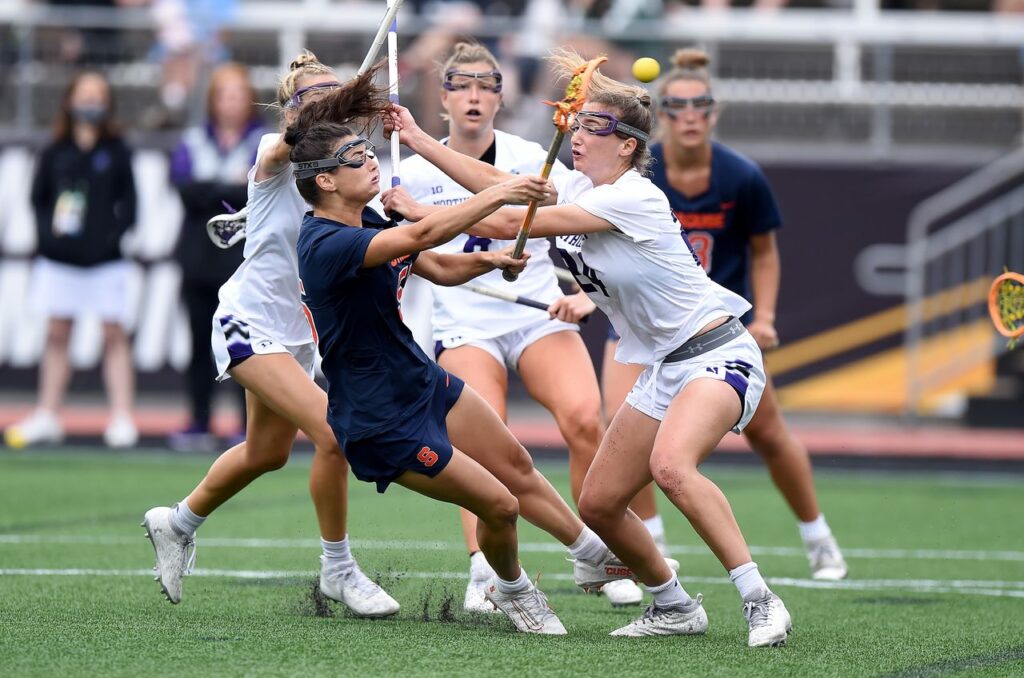
Technical Fouls
A technical foul in lacrosse is a penalty assessed for violating the rules of play. There are many different types of violations that can result in a technical foul, including physical contact with an opponent, unsportsmanlike conduct, and failure to comply with the direction of an official. Generally, these violations are considered very serious and often result in harsher disciplinary measures than other infractions.
Technical fouls can be assessed against players or coaches through verbal warnings or written citations. Depending on the severity of the violation and the administrator’s discretion, punishments may range from verbal reprimands to game ejections and suspensions. If a player is ejected from a game due to incurring two technical fouls, they may be ineligible for their next scheduled game as well. Coaches may also receive suspensions if they have accumulated multiple technical fouls throughout the season.
In addition to disciplinary action taken by officials, there may be other consequences associated with receiving a technical foul in lacrosse. These could include fines issued by national governing bodies or even expulsion from competitive leagues. Depending on the circumstances surrounding the violation, student-athletes may also face academic penalties like reduced playing time or suspension from practice or competition until grades improve.
Conclusion
Lacrosse is a great game that can bring joy and excitement to competitors of all skill levels. It is a physical, fast-paced team sport that requires players to think quickly on their feet while exhibiting excellent hand-eye coordination. Lacrosse also contains several unique features such as the use of a stick with a net on its end to pass, catch, and shoot the ball.
In addition to its technical nuances, lacrosse has many strategic elements such as the use of different formations and set plays that require strategy and communication between teammates. It is not only fun for players but captivating for spectators as well. From watching the speed of a breakaway goal to celebrating in unison after a long possession ends in an impressive score, lacrosse provides an unforgettable experience no matter what role you take in the game.
- Super Heinz Betting Explained - April 22, 2024
- Betting Strategies: Heinz Bet Explained - April 18, 2024
- What is a Yankee Bet and How Does it Work - April 17, 2024



